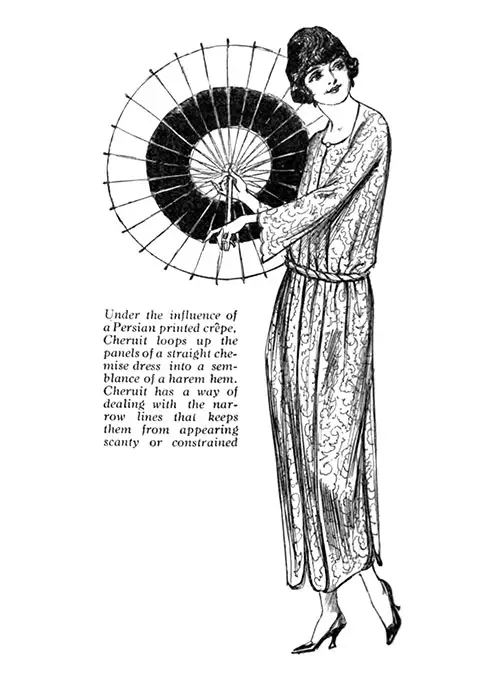Louise Chéruit - Parisian Fashion Designer - 1920

Abpve: Under the influence of a Persian printed crepe, Chéruit loops up the panels of a straight chemise dress into a semblance of a harem hem. Chéruit has a way of dealing with the narrow lines that keeps them from appearing scanty or constrained (The Delineator June 1919)
An extensive and brilliant collection is that shown by Cheruit—consistent in the sense that the same remarkably clear, good line is preserved throughout, and very varied as to stuffs, colors, and trimmings.
I am going to begin, contrary to all rules, with the large exhibit of fur wraps, coats, and capes, the first outnumbering the second by far. Ermine, sable, mink, kolinsky, mole garments all have high loose collars and sleeves starting from the waist.
Broadtail, repeated several times, is once fringed and collared in monkey, another time it has a ruched black satin collar and plain silk hem. A three-quarter gazelle coat's collar is tied by a ribbon imitating snakeskin.
Capes are not very long nor voluminous; one is edged all around in gray goat. A blue and yellow plaid costume has a cape, pleated in the back only; at the top is placed a large square of skunk, which covers the shoulders and forms the collar as well.
A delightfully new trimming on a white blanket cloth coat consists of a massive embroidery from hips to hem of ermine tails sewn on in a criss-cross pattern. A second most elaborate white satin coat is covered in very much the same design, done this time in alternately plain and pleated white ribbon.
A shortish coat of spotless white rabbit has a shirred white satin collar tied with black satin, the effect being rather unforeseen, very chic and simple.
The general silhouette at Cheruit's is loose and straight, though by no means narrow; applied to tailor-mades, this gives skirts shirred all around but not voluminous and a little longer than usual.
The average coat is three-quarters, with big loose revers falling open, shawl fashion; low waists, the material embroidered at the belt to accentuate this fact, the sides of the basques may be gathered.
The stuffs are blanket, corduroy, velours de laine, and a new material, Popelaburc circudrée, sacking with a beige center framed in a broad black selvage.
The leading colors are greens, mole, mouse, elephant, and nègre. A three-quarter suit of bottle-green velours has pleated sides to the basques and a scarf collar of gazelle.
A bright blue cape costume attracted my attention; the cape, quite short, edged with a fringe of monkey, is worn with a plain dress merely trimmed by a low, rolled broad belt of the material at the hips. For the dresses have low belts of the stuff, giving a more decidedly than ever long waist.
The best stuffs are duvetyn, a fine melton, and a sort of thin cloth, kashavella, in beige, peach, orange, negre, réseda, arsenic, eucalyptus.
Many dresses may be classed apart as having no trimming but that provided by the clever handling of the stuff itself. For instance, an orange is guiltless of adornment except for the collar; it is high at the back, and in front forms, two broad streamers of unequal length edged with black satin. Another example merely has a big shawl collar opening to the waist over a muslin guimpe.
There are no coat-dresses, properly speaking, none of the gowns being sufficiently tailored in aspect for that. Sleeves are very large; enormously wide ones are cut into bands or sections of different colored materials: others form part of a shawl back coming over the front; wide sleeves have big rings of fur at intervals down the arms. Collars are semi-high, often a loosely rolled hand around the neck.
Among the various tendencies, we have the flat apron movement illustrated in arsenic-green melton, the apron from knee to hem adorned by three rows of finely pleated ruffles: dresses draped from hip to hip in flat wrinkles and buttoned to one side.
A gray crepe dress has detached loops of unequal lengths edged with squirrel turned up over and under a wide low belt. The dress is often longest at the sides. A black crepe de Chine frock with pleated sleeves and rolled collar has a wide detached front panel embroidered in fine red ribbon.
Ribbon trimmings, pleated or plain, in big bold patterns are favorites here; wooden beads are used to stripe the sides of a brown satin gown; thin beige wool embroidery on black net makes blurred floating panels on black velvet.
Cut-out applications of velvet leaves are to be found on a reddish brown jersey. An orange duvetyn has a novel embroidery in the way of different colored woolen blobs sewn onto it in a small design.
For the evening, materials are light in tone, yellow, coffee, nasturtium, réseda and white among them. There are no heavy, rich metallic stuffs: moiré, charmeuse, velvet, and ottoman make up the bulk of the collection. The neckline is always round, bigger at the back; the trains are very often the ends of the sash, and as such, long and slender.
"Cheruit" in the Garment Manufacturers’ Index, New York: The Allen-Nugent Co. Publishers, Vol. II, No. 3, October 1920: 22. Image from The Delineator, June 1919: 87.
